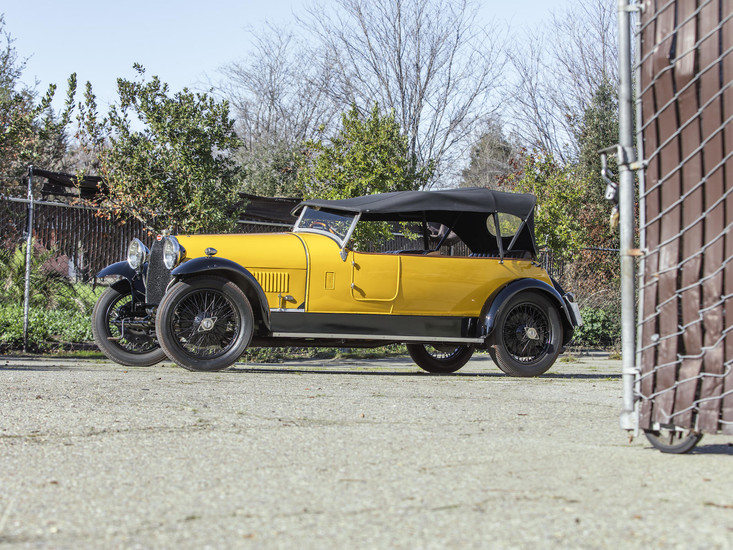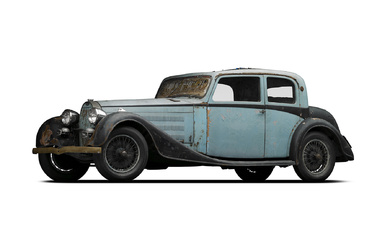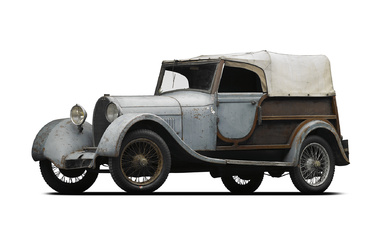1925 Bugatti Type 30 Sports Tourer
1925 Bugatti Type 30 Sports Tourer
Chassis no. 4725
Engine no. 418 (see text)
1,991cc SOHC 24-Valve Alloy 8-Cylinder Engine
2 Solex Side-draft Carburetors
100bhp at 4,500rpm
4-Speed Manual Transmission
Leaf Spring Suspension
Front Hydraulic – Rear Mechanical Drum Brakes
*Well-documented and pedigreed Type 30
*Desirable and handsome open Sports Tourer coachwork
*Researched by Bugatti historians and formerly part of prominent collections
*A powerful, 8-Cylinder Bugatti eligible for prominent tours and rallies
THE BUGATTI TYPE 30
'Bugattis encapsulate concepts of engineering which, once seen, change your ideas radically and definitively. Drive them, and you realize that each car is form and engineering in equilibrium, and a work of art.' – William Stobbs, Les Grandes Routières.
Introduced in 1922, the Type 30 Bugatti has a special place in motoring history, for it was the first small 'straight-eight' to go into production and the first to use Bugatti's classic single-overhead-cam engine, one of the most famous automobile power units of all time. Typical of the time, the Bugatti 'eight' was a 'long-stroke' design of 60x88mm bore/stroke for a capacity of 1,991cc. The three valves per cylinder were operated by single gear-driven overhead camshaft, while the crankshaft was carried in three roller bearings with plain big ends. Breathing via twin Solex carburetors, this jewel-like power unit produced approximately 100bhp at 4,500rpm.
This engine was installed in what was essentially a Brescia type chassis, resulting in a car that was notably fast and powerful for its day, possessing many of the characteristics of the racing Bugattis. The eight-cylinder engine was very flexible and, once mastered, the Brescia-type gearbox a delight to use. Of some 600-or-so Type 30s produced, fewer than 50 are known to survive today, with original examples possessing known history especially desirable.
THE MOTORCAR OFFERED
Offered here is a lovely example of the racing-derived, eight-cylinder Bugatti Type 30, featuring elegant open Sports Tourer coachwork. Well documented and recached, Dutch Bugatti historian and expert Kees Jansen has compiled a dossier on this fine example, chassis no. 4725, and notes that the new Bugatti was ordered by Bugatti agent Dubuisson of Saint-Quentin, France for his customer Monsieur Chavel. The chassis was completed at the famous Bugatti Works in Molsheim, Alsace France in January of 1926 to then be clothed by a coachbuilder of Dubuisson's choice in the elegant two-door Sports Tourer configuration featuring the rakish vee'd windscreen as seen on the car today. The Bugatti was driven on garage plates 1651 WW5 by Bugatti racing driver, Louis Charavel, who was known to compete under the pseudonym of Sabipa. Once delivered to Monsieur Chavel, Bugatti Type 30 chassis no. 4725 would remain in his ownership until 1960, when it was acquired by J.P. Léger of Dreux, France. A photograph from this period in Yan Verdier's famous book Une Vie pour Bugatti shows Bugatti Type 30 chassis no. 4725 at Henri Novo's famous Bugatti garage with the engine removed, and at this point the Sports Tourer would receive the engine fitted in the car today, engine no. 418; a period correct Type 30 engine. Bugatti Type 30 chassis no. 4725 would receive its current and very appropriate color scheme of yellow over black chassis, fenders and wire wheels around this time. The next custodian of Bugatti Type 30 chassis no. 4725 would be renowned French collector Monsieur Henri Chambon, who would acquire the car in 1972. Chambon would use the car and showed it at a Bugatti meet in Denmark during the 1970s.
From Chambon's ownership, the Bugatti passed on to another well-known French collector, Monsieur Bernard Viallon. Viallon had many great Bugattis, and his cars were famously used for color illustrations in the legendary book Bugatti Magnum, written by renowned Bugatti historian Hugh Conway. Type 30 chassis no. 4725 is illustrated on page 111 and 112. The elegant Bugatti Type 30 Sports Tourer would later be exported to the United States, where it has resided in a prominent collection for the past two decades.
Today, this stunning Bugatti shows beautifully throughout. The engine compartment displays the powerful eight-cylinder all-aluminum engine, featuring the overhead camshaft operating 3 valves per cylinder. The two brass Solex carburetors are polished and give the compartment an impressive look. The cockpit is trimmed in dark wood and neatly contrasting chocolate-colored leather hides. The classic four-spoke wood rimmed Bugatti steering wheel sits in front of the beautiful white-faced instruments and gauges by Jaeger, Paris. A black convertible top and rear mounted spare wheel is fitted, and large Marchal headlamps with yellow reflectors grace the front, as does the classic Bugatti horseshoe shaped radiator.
According to contemporary press reports, the Type 30 was 'A full blooded, real man's motor-car, by intention and performance' and '4724', with its graceful Sports Tourer coachwork, is a particularly fine example of the marque.
View it on
Estimate
Time, Location
Auction House
1925 Bugatti Type 30 Sports Tourer
Chassis no. 4725
Engine no. 418 (see text)
1,991cc SOHC 24-Valve Alloy 8-Cylinder Engine
2 Solex Side-draft Carburetors
100bhp at 4,500rpm
4-Speed Manual Transmission
Leaf Spring Suspension
Front Hydraulic – Rear Mechanical Drum Brakes
*Well-documented and pedigreed Type 30
*Desirable and handsome open Sports Tourer coachwork
*Researched by Bugatti historians and formerly part of prominent collections
*A powerful, 8-Cylinder Bugatti eligible for prominent tours and rallies
THE BUGATTI TYPE 30
'Bugattis encapsulate concepts of engineering which, once seen, change your ideas radically and definitively. Drive them, and you realize that each car is form and engineering in equilibrium, and a work of art.' – William Stobbs, Les Grandes Routières.
Introduced in 1922, the Type 30 Bugatti has a special place in motoring history, for it was the first small 'straight-eight' to go into production and the first to use Bugatti's classic single-overhead-cam engine, one of the most famous automobile power units of all time. Typical of the time, the Bugatti 'eight' was a 'long-stroke' design of 60x88mm bore/stroke for a capacity of 1,991cc. The three valves per cylinder were operated by single gear-driven overhead camshaft, while the crankshaft was carried in three roller bearings with plain big ends. Breathing via twin Solex carburetors, this jewel-like power unit produced approximately 100bhp at 4,500rpm.
This engine was installed in what was essentially a Brescia type chassis, resulting in a car that was notably fast and powerful for its day, possessing many of the characteristics of the racing Bugattis. The eight-cylinder engine was very flexible and, once mastered, the Brescia-type gearbox a delight to use. Of some 600-or-so Type 30s produced, fewer than 50 are known to survive today, with original examples possessing known history especially desirable.
THE MOTORCAR OFFERED
Offered here is a lovely example of the racing-derived, eight-cylinder Bugatti Type 30, featuring elegant open Sports Tourer coachwork. Well documented and recached, Dutch Bugatti historian and expert Kees Jansen has compiled a dossier on this fine example, chassis no. 4725, and notes that the new Bugatti was ordered by Bugatti agent Dubuisson of Saint-Quentin, France for his customer Monsieur Chavel. The chassis was completed at the famous Bugatti Works in Molsheim, Alsace France in January of 1926 to then be clothed by a coachbuilder of Dubuisson's choice in the elegant two-door Sports Tourer configuration featuring the rakish vee'd windscreen as seen on the car today. The Bugatti was driven on garage plates 1651 WW5 by Bugatti racing driver, Louis Charavel, who was known to compete under the pseudonym of Sabipa. Once delivered to Monsieur Chavel, Bugatti Type 30 chassis no. 4725 would remain in his ownership until 1960, when it was acquired by J.P. Léger of Dreux, France. A photograph from this period in Yan Verdier's famous book Une Vie pour Bugatti shows Bugatti Type 30 chassis no. 4725 at Henri Novo's famous Bugatti garage with the engine removed, and at this point the Sports Tourer would receive the engine fitted in the car today, engine no. 418; a period correct Type 30 engine. Bugatti Type 30 chassis no. 4725 would receive its current and very appropriate color scheme of yellow over black chassis, fenders and wire wheels around this time. The next custodian of Bugatti Type 30 chassis no. 4725 would be renowned French collector Monsieur Henri Chambon, who would acquire the car in 1972. Chambon would use the car and showed it at a Bugatti meet in Denmark during the 1970s.
From Chambon's ownership, the Bugatti passed on to another well-known French collector, Monsieur Bernard Viallon. Viallon had many great Bugattis, and his cars were famously used for color illustrations in the legendary book Bugatti Magnum, written by renowned Bugatti historian Hugh Conway. Type 30 chassis no. 4725 is illustrated on page 111 and 112. The elegant Bugatti Type 30 Sports Tourer would later be exported to the United States, where it has resided in a prominent collection for the past two decades.
Today, this stunning Bugatti shows beautifully throughout. The engine compartment displays the powerful eight-cylinder all-aluminum engine, featuring the overhead camshaft operating 3 valves per cylinder. The two brass Solex carburetors are polished and give the compartment an impressive look. The cockpit is trimmed in dark wood and neatly contrasting chocolate-colored leather hides. The classic four-spoke wood rimmed Bugatti steering wheel sits in front of the beautiful white-faced instruments and gauges by Jaeger, Paris. A black convertible top and rear mounted spare wheel is fitted, and large Marchal headlamps with yellow reflectors grace the front, as does the classic Bugatti horseshoe shaped radiator.
According to contemporary press reports, the Type 30 was 'A full blooded, real man's motor-car, by intention and performance' and '4724', with its graceful Sports Tourer coachwork, is a particularly fine example of the marque.







